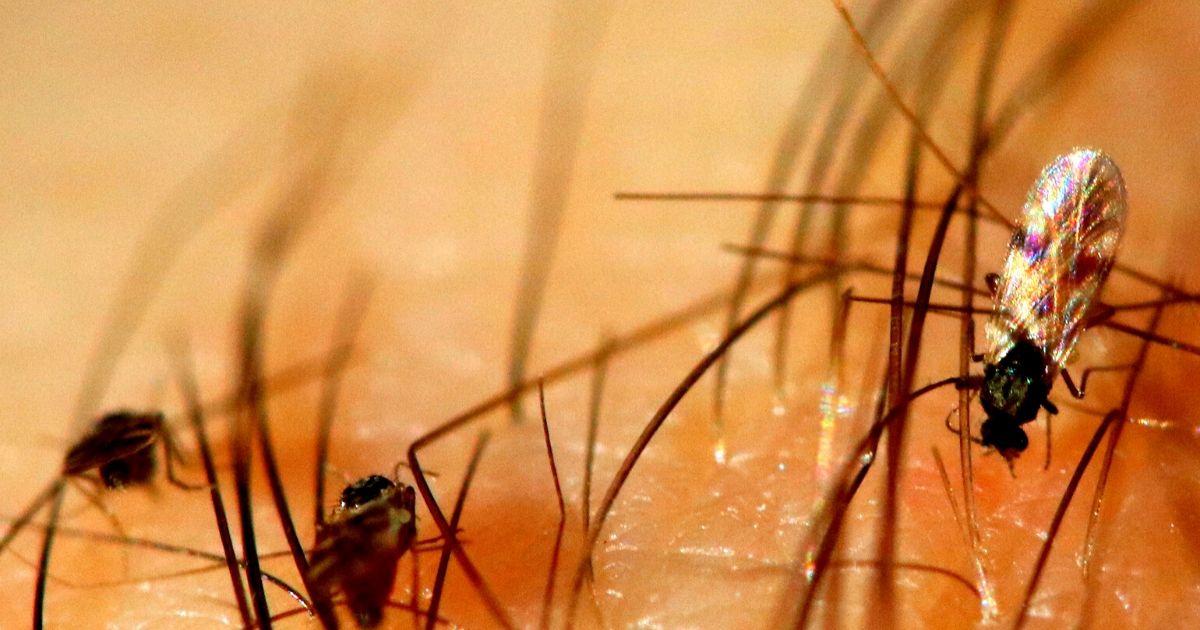The Complete Guide to the Prevention, Treatment and Control of Midges in Singapore
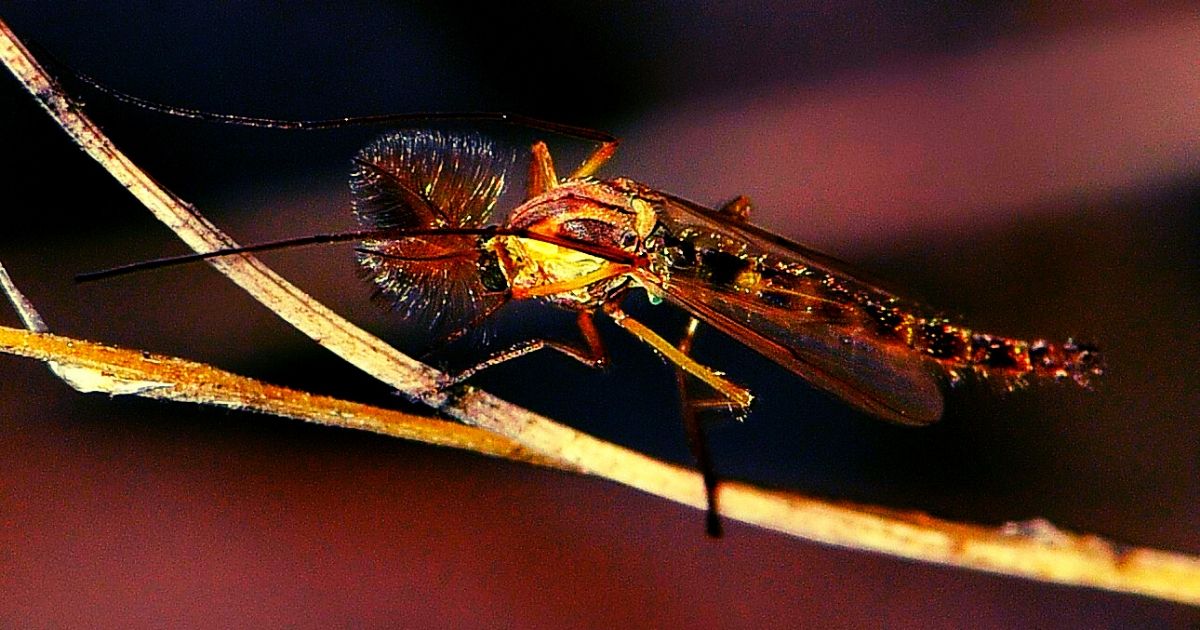
Midges are common insects in urban environments. In Singapore, it is not unusual to see swarms of midges near reservoirs. These areas provide favorable conditions such as ample food in the water and optimal temperature during certain times of the year. Midges are often mistaken to be mosquitoes because of their similar appearance. However, you can actually recognize midges if you look closely. Their bodies are slender and longer compared to mosquitoes. Most of the midges found in Singapore have distinct green bodies.
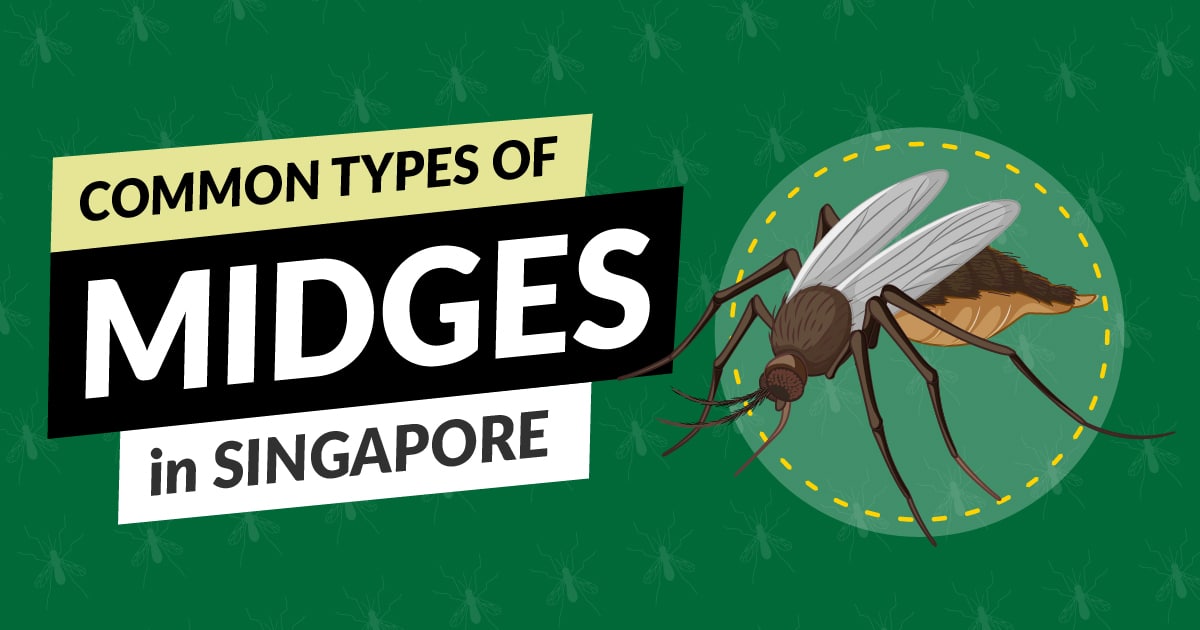
Types of Midges
Midges can be categorized into two main groups, namely:
Biting midges found in Singapore are in the family of Ceratopogonidae, while non-biting midges are in the family of Chironomidae. In Singapore, biting midges are also known as sand flies, but some may call them “No-See-Ums”. As the name implies, biting midges are bloodsuckers, leaving painful bites on human and animal skins. On the other hand, non-biting midges do not bite and feed like biting midges. Non-biting midges do not cause and transmit diseases to humans as mosquitoes do. However, they are defined as nuisance pests to humans.
Life Cycle and Biology
The life cycle of midges is similar to that of mosquitoes. The life cycle of both biting and non-biting midges involves four development stages, namely:
- Egg
- Larval
- Pupal
- Adult
Biting midges
The complete life cycle of biting midges takes about 2 to 6 weeks, depending on the species and environmental factors. Both male and female biting midges feed on nectar. However, females require human or animal blood for their eggs to mature. Females usually fly into the male swarms for mating. This occurs when females finish feeding on blood.
Larvae development requires a moisture source. They need water, air and food for survival. Larvae develop in ponds, streams or muddy substrates, and they feed on organisms around them. The pupae stage can last from 2 to 3 days. The lifespan for an adult biting midge is usually up to a few weeks.
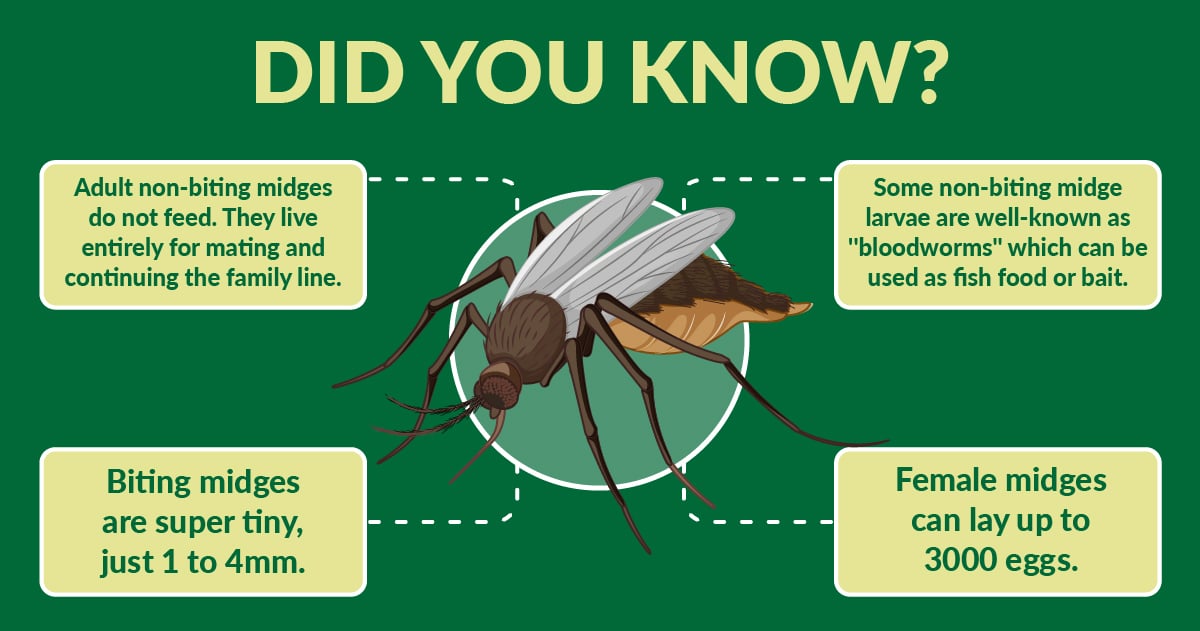
Non-Biting Midges
Non-Biting midges do not possess proboscis. The proboscis is a needle-like mouthpart found on insects such as mosquitoes and biting midges. It is an important feature used to suck blood.
The breeding habitats of non-biting midges are similar to mosquitoes, namely in stagnant water and slow-flowing water. Common places where you can find them are drains, water reservoirs, water tanks, ponds and lakes.
The complete life cycle takes about three weeks to complete. Non-biting midges have a better reproductive capability than biting midges. Females can lay eggs in masses that contain up to 3000 eggs. The larvae feed on sediments or organic matters in the water.
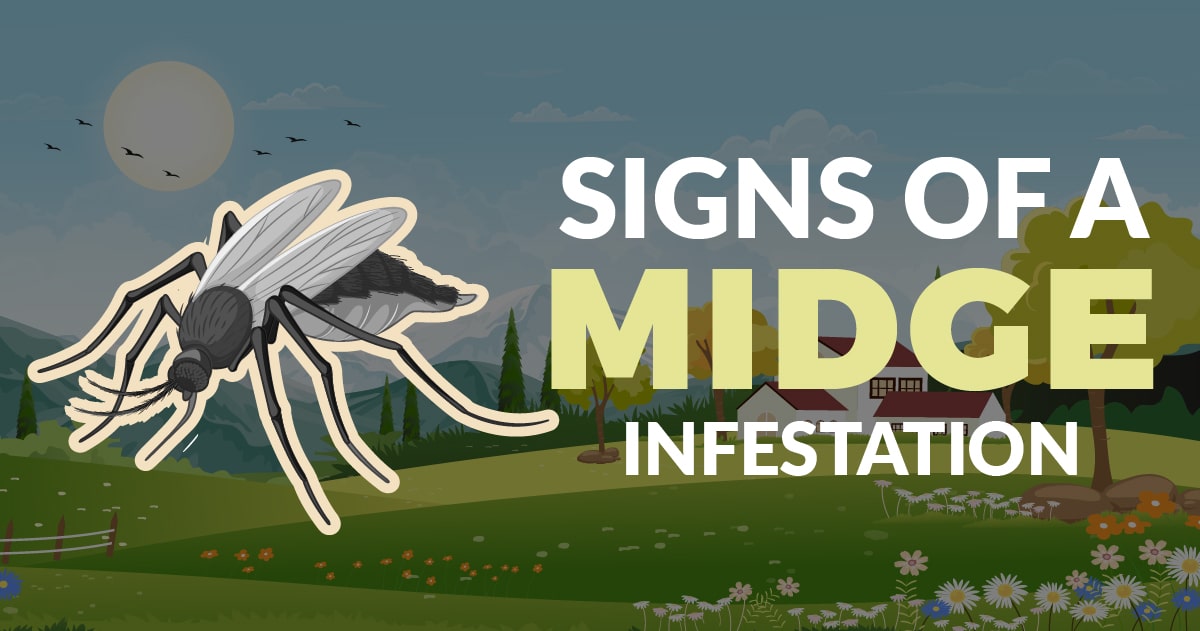
Signs of Midge Infestations
The swarming of midges is the most obvious sign of a midge infestation. You can notice the swarms, especially during dawn and dusk. Non-biting midges are harmless but are a nuisance to people. However, biting midges or sand flies can deliver painful bites, leaving red bumps that cause an itch.
Interesting fact: Some adult midges look similar to mosquitoes, but unlike mosquitoes, they do not eat or drink, and their bodies are usually longer and more slender.
Medical Importance of Biting Midges
Biting midges can cause a disease called leishmaniasis. Not to worry, there is no endemic transmission record of this disease in Singapore. Besides, the species that cause this disease are Phlebotomus and Lutzomyia spp., which do not appear active in Singapore.
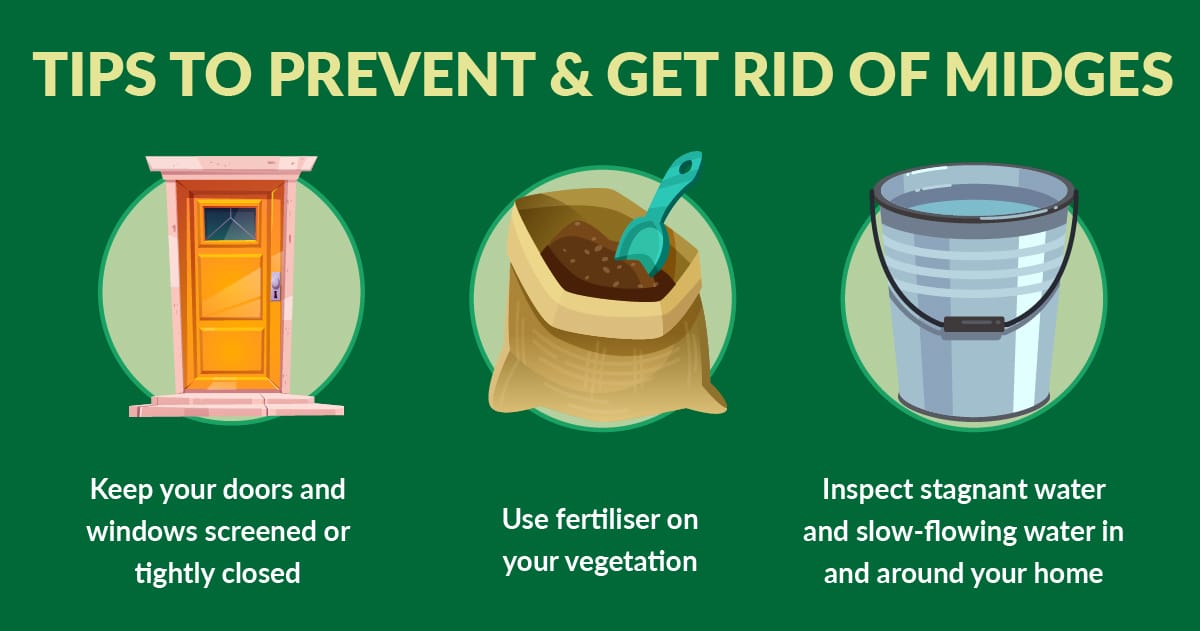
How to Prevent Midges In and Around your Home
1. Keep your doors and windows screened or tightly closed
To screen your windows, the wire mesh size must be small enough to exclude all species. Ensure always to remind yourself to close doors and windows, especially during dusk and dawn, as these are midges’ most active hours. Prevention during this time prevents Aedes mosquitoes as well. If you are not planning to screen your windows, you may install curtains to lower the chances of denying their access.
2. Always inspect stagnant water and slow-flowing water in and around your home
As previously mentioned, the developmental stages of the midges are similar to mosquitoes. They need to go through larval and pupal stages before emerging as adults. Midge larvae are most likely to be found in reservoirs, lakes and ponds. Other than that, they can be found in stagnant and slow-moving water.
The greenery and plants around the home are the most susceptible areas to become their breeding habitats. Stagnant water found on soil, in planter plates, or in boxes can become potential breeding places. Besides, the soil nutrients further contribute to the growth of their larvae, giving them access to ample food and enough water to survive through their developmental stages
3. Use fertiliser
Midge larvae prefer to develop in nutrient-rich habitats. Always remember to fertilise your plants properly by checking and following the guidelines of the fertiliser used. This is to prevent excessive use of fertiliser, resulting in fertiliser runoff in the soil to the surrounding ponds, drains, and streams. The excessive use of fertiliser can promote their growth of development as nutrients are drained from the soil to their breeding habitats.
Tips to Prevent and Get Rid of Midges (DIY Methods)
1. Use insect repellents
Insect repellents aim to repel midges away from you without killing them. Some people may have sensitive or allergy skin towards chemical-laden repellents. To protect sensitive skin from chemicals, you may apply natural insect repellents that contain substances such as citronella and tea tree oil from the market.
Although non-biting midges do not bite and transmit diseases, they can be a nuisance. Application of insect repellents is the easiest and most environmentally friendly method to protect you from midges‘ disturbance.
2. Use dim or yellow lights
Midges are highly attracted to bright light. Hence, yellow or dim light bulbs are advised, especially at doors and windows. In addition, you can always switch off the lights that are not in use in the exterior part of your home. This method is not aimed at eliminating midges but can help to reduce the presence around your living environment.
3. Make the environment less conducive (eliminate their habitats)
The reasons for midges to breed around your home are always the presence of stagnant and slow-moving water bodies. This includes over-watering of plants, hardened soil and insufficient drain gradient. Overwatering of plants and hardened soil in the planter boxes often cause the formation of stagnant water on the soil.
Always make sure to loosen the soil regularly and avoid over-watering plants to prevent the formation of ponding water. On the other hand, you may need to remove blockages such as stones, dry leaves, debris and algae formed in the drains regularly to improve the flow of drain water. You may also re-grade your drain if a poor gradient was found as midge larvae can withstand the weak water current in the drain.
4. Use Bti or mosquito dunk
Bti (Bacillus thuringiensis israelensis) or mosquito dunks can easily be bought in stores. These can be placed safely in and around your home if the formation of stagnant water bodies is difficult or troublesome to be cleared.
Bti is a bacterium that can infect the guts of mosquitoes and midge larvae. It is environmentally friendly as it does not affect or kill beneficial insects, aquatic animals and plants. Bti can be introduced into ponds, poorly maintained water fountains and gutters.
7 Tips on How to Get Rid of Midges

Professional Midge Treatment
It is quite a simple task to deal with a small number of midges present at your premises. However, it can become challenging to control midges when their numbers increase and start affecting your daily life.
The treatment methods used in Singapore for midges can be divided into the following methods:
- Physical
- Biological
- Insecticidal
The most basic physical method is the removal of their breeding sources. Inspection plays a vital part in this. Remove midges‘ breeding source via S&D (search and destroy). However, some other methods have been used in Singapore. For example, a 3 metres high netting was introduced at the reservoirs to prevent midges from flying or being blown to the residential areas. Besides, spotlights were deployed remained switched on from 7 am to 7 pm to attract and keep midges within the reservoirs.
The application of Bti (Bacillus thuringiensis israelensis) is one of the biological methods that the government and pest control industries use. This is because it is safe (no risk to humans, animals and aquatic life), target specific and does not affect the water quality. Another biological method that the government uses is the release of predators to hunt for midge pupae (the prey), reducing the population of adult midges. In Singapore, thousands of predatory fish (guppies, mollies and swordtails) were released into the reservoirs as they are the predators of midge pupae.
Furthermore, insecticidal approaches are commonly used in pest control industries in Singapore, namely:
- Thermal fogging
- Misting
- Larviciding
Thermal fogging and misting are two treatment methods to target adult flying insects, especially mosquitoes and midges. Thermal fogging targets flying insects present during the treatment period. Misting creates a residual effect on the treated surface and kills them upon contact. In short, thermal fogging acts as a “quick fix” solution to provide fast control to reduce the population of targeted insects while misting protects over a more extended period.
On the other hand, larviciding is the application of larvicide into stagnant water. It is used to target larvae before they can grow to adults. Licensed and certified companies in Singapore strictly carry out all the methods discussed here.
At Killem Pest, we provide a physical approach by carrying out S&D (search and destroy). Inspection is not an easy challenge. Our pest control professionals are trained to have the required knowledge and ability to search for midges breeding places.
Besides, environmental health is always our concern. Hence, we also offer a biological approach by providing or applying Bti upon request or in sensitive areas. In addition, all the chemicals used in insecticidal methods are approved by NEA (National Environment Agency). The chemicals do not pose harmful effects to humans and animals.
Frequently Asked Questions
Midges don’t transmit any human diseases, however, it’s known that their bites can be painful and can cause a severe allergic reaction.
Midges can cause discomfort for people, but they are not considered dangerous. On the other hand, midges can spread diseases to animals, like livestock, and can be considered deadly.
The best way to protect yourself from biting is to cover up your skin. Choosing light-coloured clothing can also help, as midges are attracted to dark colors.


